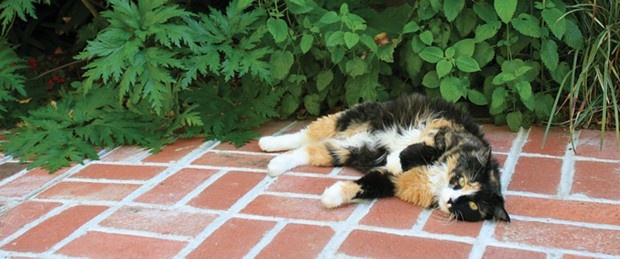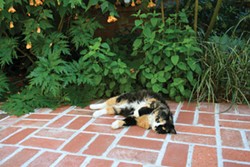[
{
"name": "Top Stories Video Pair",
"insertPoint": "7",
"component": "17087298",
"parentWrapperClass": "fdn-ads-inline-content-block",
"requiredCountToDisplay": "1"
}
]
Anyone with pets knows what integral parts of the family they become, yet Fluffy and Fido's antics in the landscape — the digging, peeing and damaged plants — can try any gardener's good nature. Here's how to create a backyard refuge that all the members of your family can enjoy.
Dogs in the garden
The natural exuberance with which dogs approach life sets a good example for all of us, yet their energy can pose a challenge when trying to keep plants alive. Here are some dos and don'ts for gardening with dogs.
Do let your dogs have a few pathways. Most dogs wear pathways through the garden, whether around the perimeter to guard their territory, an as-the-crow-flies shortcut through your favorite flower bed or across the lawn to a napping spot. Though you can try to retrain them out of trampling delicate plants by placing obstacles such as boulders or little wire fences in their path, creatively planning for them to use the garden in the way they find most natural (whenever possible) keeps your expectations in check and everyone's blood pressure down. For example, if your dog likes to run the periphery, keep new plantings a few feet back from the fence and remove the lowest branches from shrubs and trees so Fido can sprint without causing damage.
Do protect new plants from diggers. Dogs may dig because they hear a gopher underground they'd like to catch (good dog!), because they want a cool bed to lay in or because, like terriers and some other breeds, they're born to dig. Solving the underlying problem — by safely getting rid of gophers and moles or providing appealing, shady resting spaces — is your best bet. But if you have an incorrigible digger, you may need to run low wire fencing through the most commonly dug areas to discourage visiting, put down a layer of chicken wire underneath the mulch surrounding new plantings or vegetable gardens (roll any sharp edges under so exploring paws aren't hurt and hold the wire in place with Dewitt anchoring pins), or put mid-size rocks around the base of new plants until they have established sturdy roots. Avoid weed mat though; once shredded, it's a real pain to repair or replace.
Don't use cocoa mulch. Cocoa bean shells are a byproduct of chocolate production and have a sweet smell similar to a melted chocolate bar. Though it is an expensive choice for mulch, many people use it in small spaces around patios or in containers. Unfortunately, dogs are attracted by the sweet scent and may eat enough to cause health problems. Choose a natural wood chip mulch instead.
Do use liquid organic fertilizers. Particularly if you have a digger, the deliciously fragrant lure of bone and blood meal can prove too much for your dog to resist. Instead of setting out granular organics, choose a liquid formulation that can be thoroughly watered in to dilute the odor and discourage digging.
Don't let the lawn become spotted. I notice two frequent issues with dog urine and lawns: yellowish green grass with lush green patches where the dog has gone, or lush green with dead spots. Neither is necessary. Cleaning up after your dog promptly and rinsing those areas dilutes the acidity and nitrogen in the urine and helps prevent spots on your grass. You can repair any dead patches quickly by raking out the old foliage, then topdressing with a handful of compost mixed with garden lime and grass seed. If you have the opposite problem and grass looks better where the dog has been, it's a sign your lawn would benefit from a light dose of organic lawn fertilizer such as Gardner and Bloome (water it in well to discourage Fido from rolling in it).
Do give the garden a periodic overhead sprinkle. The burning acidity of dog urine is a huge issue on flowering plants and small shrubs (heather, boxwood and hebe are particularly susceptible), so if you notice your dogs "pollinating" plants, get out the hose and rinse them as soon as possible. Since they are likely lifting their legs in other locations when you are not watching, make it a habit to hose off the foliage in the entire garden a couple times a month. I know we are in a drought, but given how much water it takes to establish a new plant, keeping your current plants alive is definitely a waterwise choice.
Don't plant anything poisonous around puppies or chewers. While most mature dogs can be trusted not to eat the shrubbery, a number of common plants like sago palm, rhododendron, and foxglove are especially toxic when eaten in any quantity. The ASPCA keeps an extensive list with photographs of plants toxic to dogs and cats at www.aspca.org.
Cats in the garden
Cats pose far fewer challenges to gardeners, but many wildlife advocates advise keeping cats indoors due to their threat to songbird and hummingbird populations. Cats can also make vegetable gardening or other parts of the garden unsanitary. Yet their needs for garden happiness are fairly simple. Here's how to make a cat-friendly space.
Don't use tiny woodchips. For aesthetic reasons, I generally prefer the smallest size of wood chip mulch available, yet the refined look of micro-mini fir bark is spoiled by the certain knowledge that those little volcano-shaped piles around the landscape are covering litterbox-style "presents." Even a single step up in size to small fir bark, redwood chips or walk-on bark will almost entirely eliminate the issue.
Do vegetable gardening vertically whenever possible. Though the soft soil of a raised garden bed can be covered with a layer of hog or chicken wire to discourage digging by cats, if you have a sunny garden fence, consider keeping food gardening out of reach by using a series of tall pots, a vertical gardening wall setup or hanging pots or baskets on the fence or under the eaves of your porch. This skirts the issue of potential feces-borne pathogens in your raised beds.
Don't give your cat a free lunch. Put a bell on your kitties' collars so birds can hear them coming. If you use birdfeeders, keep the nearby garden area fairly clear so birdies can see anyone trying to sneak up on them. It's also a good idea to provide a few places for birds to perch and scope out the scene before landing on the feeder. A couple of small trees nearby or tall shrubs limbed up to create a treelike form allows birds to land safely out of reach, look around and escape quickly.
Do give kitties a place to perch. Cats, like birds, like to survey their territory and relax on high ground, especially if you also have chickens, toddlers or dogs in the backyard with them. From the cats' perspective, the biggest hit in our garden has been a series of small wooden shelves a few feet up on garden fences and structures like the chicken coop. We chose soft, roughly textured wood so they could easily sink their claws in when jumping up, and they enjoy having a place to nap away from the prying eyes and pecking beaks of the chickens.
Do plant something fun. Kitties love the way ornamental grasses rustle in the wind, and our patches of New Zealand wind grass have been the setting for numerous games of pounce. Our catmint is regularly flattened by a drowsy feline lounging in the sun. If you don't have a lush organic lawn, consider keeping a few pots of kitty grass near the cat door so they can munch as they go in or out.
For a detailed monthly to-do list, visit www.northcoastjournal.com/GardenTodo.
Genevieve Schmidt owns a fine landscape maintenance company in Arcata. Visit her on the web at www.GenevieveSchmidtDesign.com.
more from the author
-
Gardening Grab Bag
What's new and cool in the gardening world
- Jun 2, 2016
-
Tackling Weeds Organically
- May 5, 2016
-
The Illusion of Water in the Low-Water Garden
- Apr 7, 2016
- More »

































